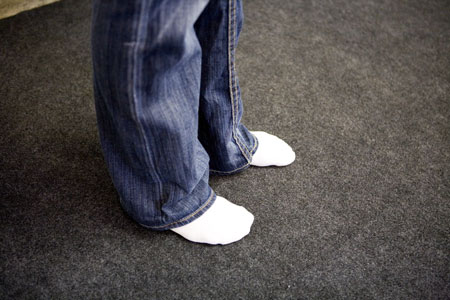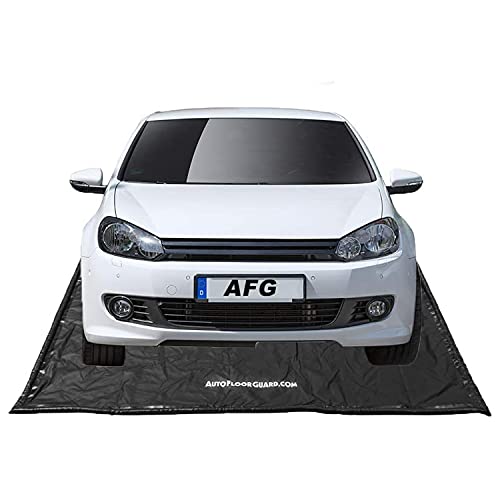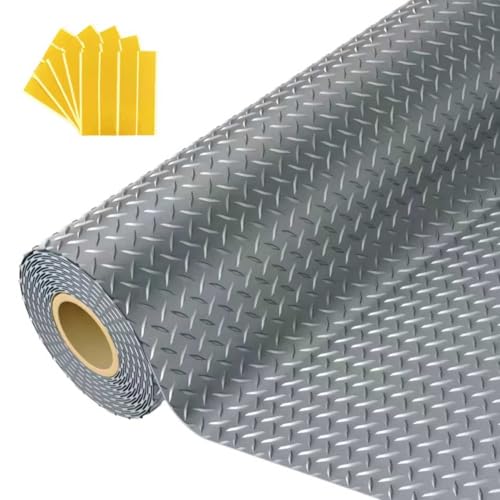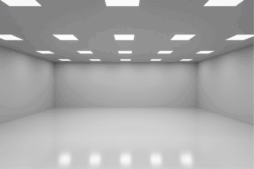Are Garage Mats Really Worth the Investment?

After shoveling a neighbor’s driveway, you might notice a white coating on their garage floor. That residue is salt left behind when snowmelt evaporates from a car. If that gets wet again, it’s going to eat away at the garage floor, causing permanent damage.
So, will garage mats protect that floor? Are they a worthwhile expense?
Yes, garage mats are absolutely worth the cost, offering one of the highest returns of any garage floor covering. They are a powerful defense against damage from ice, salt, snow, water, oil, and grease. The better question isn’t if you need one, but rather, “Which garage mat is the best fit for my garage?”
While installing racecar-style PVC floor tile is an exciting project, mats provide an inexpensive and effective way to prevent concrete damage. Snow, rain, and ice leave behind moisture which, when mixed with road salt, causes spalling and pitting in concrete floors. Garage floor mats shield the floor from these corrosive materials that can permanently damage and stain the concrete.
Ultimately, mats are a simple investment with a huge payoff. Keeping ice, sand, dirt, and salt off the floor protects it from costly damage, a fact confirmed by flooring experts who state that mats protect against salts, chemicals, and water damage. For more detailed information, see our other post: Garage Floor Mat Materials — Choosing the Best Mat Material for Your Needs
Which Type of Garage Mat Is Right for You?

The best garage floor mat for your space will be an oil mat, a parking mat, a containment mat, or a rollout floor. Making the right choice depends on a few key factors, as detailed in guides comparing the pros and cons of different garage floor coverings.
First, consider your budget. How much are you willing to invest in protecting your garage floor for the long term?
Next, think about appearance. Are you looking for a purely functional mat, or do you want something that improves the overall look of your garage?
Finally, identify the level of protection you need. Are you primarily concerned with oil drips, snowmelt, sand, road salt, or all of the above?
Do you want to cover just the area under the car or the entire garage floor? Oil, parking, and containment mats protect the immediate area under your vehicle, while rollout mats can be customized to cover any space, from a single parking spot to the whole floor.
If snow and ice melt off your car, the type of mat matters. Carpeted mats excel at absorbing oil but are less effective against moisture, whereas plastic mats hold moisture on their surface. Containment mats take this a step further with raised edges to hold in all the water that accumulates.
The Verdict: Do Garage Floor Mats Actually Work?
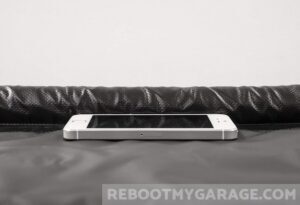
Yes, garage floor mats are highly effective at protecting concrete from oil, snow, ice, salt, sand, and dirt. They serve as a crucial barrier against the elements that cause the most harm.
As manufacturers confirm, one of the top benefits of using a mat is preventing permanent and costly damage to your concrete floor.
Carpet-style mats are excellent for protecting against oil spills but are less suited for handling significant moisture. Containment mats are specifically designed to prevent melting snow from spreading across the garage.
For a great mix of protection and appearance, rollout vinyl mats are beautiful, durable, and do an excellent job of protecting the entire garage floor from nearly any threat.
What is a Garage Floor Oil Mat?

An oil mat is a small, specialized carpet placed directly under an area prone to oil drips. These mats typically feature a rubber-backed carpet design but are also available in waterproof plastic.
An oil drip mat is versatile and can be placed on top of other floor coverings, including tiles, epoxy, or paint, to add an extra layer of protection right where you need it most.
Since oil mats are usually made of carpet, they are only partially successful at protecting the floor from snow and ice melt. They do, however, effectively protect the floor from salt and sand buildup.
To clean them, simply vacuum up dry particulates. For oil and grime, a good degreaser and a power washer will get the job done.
While oil mats are functional and not designed to be exceptionally pretty, they are highly effective at preventing unsightly and permanent garage floor staining. They tend to hold up well to studded snow tires but may shift under that kind of torque without adhesive tape.
Why Is a Containment Mat Best for Winter?

Garage floor containment mats are designed to capture the snowmelt, ice, sludge, and salt your car brings into the garage. They protect the floor from the materials that cause concrete spalling and pitting, as they are specifically designed to trap water and debris.
If your garage floor already shows signs of damage from water and salt, our article can help: How Do You Fix Garage Floor Spalling and Pitting?
A containment mat works directly on concrete or can be placed over other flooring like paint, epoxy, tiles, or even carpet for added defense.
While excellent at capturing snowmelt, these mats are usually made of thinner plastic and can damage more easily than robust vinyl and carpet mats. Turning a studded snow tire on a containment mat, for example, can potentially rip the material.
Containment mats are highly functional but don’t add much to the look of a garage. Warranties are typically for one year and often do not cover damage from studded snow tires.
When Should You Select a Garage Parking Mat?
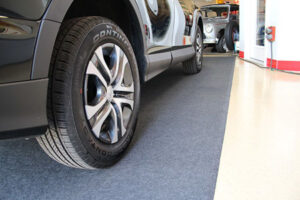
A garage floor parking mat effectively protects the floor from moisture, salt, and dirt. Vinyl and rubber versions are a better choice for moisture protection than carpet, which can trap water.
Parking mats are generally larger and heavier than oil mats, which helps them stay in place. However, you can easily use double-sided tape under any mat to keep it from moving around.
These versatile mats work well on their own or on top of other surfaces like tile, epoxy, and paint.
Parking mats are typically made of solid rubber or carpet with a rubber backing. They are strong enough to withstand studded snow tires and are resistant to ripping, even at the seams.
While they are more functional than decorative, they do an excellent job of preventing floor stains. Warranties for parking mats are usually for one year.
Full-Floor Protection: The Benefits of a Rollout Mat

A rollout mat is a single piece of flexible, heavy-duty vinyl, typically ranging from 4 to 8 feet wide and up to 25 feet long. It arrives on a roll and is deployed by simply unrolling it into place for an almost instant floor upgrade.
Rollout mats are considered a top-tier choice due to their exceptional durability and aesthetic appeal.
These mats are the heaviest and most attractive of all garage floor mat options. They are usually very thick and offer excellent protection against salt, sand, oil, gasoline, chemicals, snowmelt, and dirt.
A quality vinyl rollout mat is unaffected by studded snow tires. You can also deploy a rollout mat over an existing epoxy or painted floor for maximum protection.
They are incredibly durable and unlikely to break under any normal garage activity. Warranties reflect this quality, typically ranging from 5 years to a lifetime guarantee.
How Do Mats Prevent Unsightly Oil Stains?

While you can get a specific “oil mat” to keep oil off the floor, most other mat types also provide this benefit. Parking, containment, and rollout mats all create a barrier that protects the floor from oil.
Oil mats are a great budget-friendly option because they can be as small as the area under your car’s hood, making them less expensive than larger alternatives.
Oil and gasoline won’t necessarily eat away at your concrete, but they will certainly stain it permanently. This is why any physical barrier, from a simple mat to an epoxy coating, is a valuable form of protection against stubborn stains.
By catching drips before they hit the concrete, you preserve the clean, uniform look of your garage floor and prevent the need for harsh chemical cleaners later on.
How Can You Handle Salt and Sand Contamination?
Sand is great for providing traction on icy roads, but it creates a dusty mess in your garage. Salt melts ice effectively, but it mixes with the snow kicked up under your car.
When this salty slush melts onto your garage floor, the resulting brine mixture begins to eat away at the concrete, causing pitting and spalling.
Any carpeted or plastic garage mat will protect the floor from corrosive salt and chemicals. However, plastic is much easier to clean because it doesn’t absorb the salty water into its fibers the way carpet does, a key advantage highlighted in comparisons of flooring materials.
A carpet mat protects the floor from sand, salt, and oil, but it does not protect well from moisture. Water can build up on the concrete under the rubber backing.
In contrast, a vinyl mat protects the floor from sand, salt, oil, chemicals, and moisture. Depending on its thickness, it can even protect against gasoline spills.
How Can You Keep Your Garage Floor Dry in Winter?

When it comes to moisture protection, vinyl (plastic) mats are far superior to their carpeted counterparts. Carpet fibers tend to hold onto moisture, creating a damp environment right against your concrete floor.
This trapped moisture under rubber-backed carpets can be a significant problem. Carpeted oil mats and parking mats offer the least amount of protection from water.
Containment mats and rollout mats provide the best defense against moisture. A containment mat features raised sides specifically designed to hold onto the water from melting snow and ice.
To clear the collected water, you simply move the car and use a broom or squeegee to push the water out into the driveway. Vinyl rollout mats offer the largest coverage area and are usually made of the thickest, most protective material available, creating a completely waterproof surface.
How Do You Select the Right Mat Size?
Oil spill mats, parking mats, and containment mats are designed to protect the immediate area under your car. They are perfect for targeting a specific section of your garage that sees the most wear and tear.
In contrast, rollout mats offer incredible flexibility, with sizes ranging from half a parking spot to an entire garage bay. Consulting an expert guide on the best garage floor coverings can help you choose the right size and type for your needs.
An “oil spill” mat is typically the smallest, designed to be narrower than the car to sit directly under the drive train. A “parking mat” is usually a little wider than the car and about twice as long, providing more comprehensive coverage.
A “containment mat” is often the same size as a parking mat but with the added benefit of raised edges. “Rollout” mats come in a wide variety of dimensions, from a compact 4 ft. x 4 ft. square to a massive 8 ft. x 22 ft. roll that can cover an entire parking bay.
How Do You Install a New Garage Mat?
Installing most garage mats is incredibly simple. For an oil mat, a parking mat, or a containment mat, the process is as easy as sweeping and cleaning the floor, then putting the mat down.
The only critical step is ensuring you’re not trapping dirt, grease, or moisture underneath the mat. For help cleaning tough grime and oil, see our article Does Kitty Litter Really Clean Oil Stains?
If you find that your mat tends to move around, a few strips of double-sided tape on the underside will keep it securely in place.
If you are covering the entire garage floor with a rollout mat, you will need a few basic tools: a utility knife, a T-square, and a measuring tape.
Higher-end rollout floor manufacturers, like G-Floor, even offer specialized seaming tapes and center strips to create a seamless look when using multiple rolls.
While unrolling a single mat is easy, be aware that large vinyl rolls can be heavy and awkward to handle. If you’re just covering a parking bay, the hardest part is getting the mat into position. For a full garage installation, having some basic measuring and cutting skills will be beneficial.


